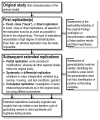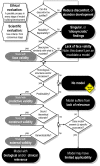Evaluation of animal models of neurobehavioral disorders
- PMID: 19243583
- PMCID: PMC2669803
- DOI: 10.1186/1744-9081-5-11
Evaluation of animal models of neurobehavioral disorders
Abstract
Animal models play a central role in all areas of biomedical research. The process of animal model building, development and evaluation has rarely been addressed systematically, despite the long history of using animal models in the investigation of neuropsychiatric disorders and behavioral dysfunctions. An iterative, multi-stage trajectory for developing animal models and assessing their quality is proposed. The process starts with defining the purpose(s) of the model, preferentially based on hypotheses about brain-behavior relationships. Then, the model is developed and tested. The evaluation of the model takes scientific and ethical criteria into consideration.Model development requires a multidisciplinary approach. Preclinical and clinical experts should establish a set of scientific criteria, which a model must meet. The scientific evaluation consists of assessing the replicability/reliability, predictive, construct and external validity/generalizability, and relevance of the model. We emphasize the role of (systematic and extended) replications in the course of the validation process. One may apply a multiple-tiered 'replication battery' to estimate the reliability/replicability, validity, and generalizability of result.Compromised welfare is inherent in many deficiency models in animals. Unfortunately, 'animal welfare' is a vaguely defined concept, making it difficult to establish exact evaluation criteria. Weighing the animal's welfare and considerations as to whether action is indicated to reduce the discomfort must accompany the scientific evaluation at any stage of the model building and evaluation process. Animal model building should be discontinued if the model does not meet the preset scientific criteria, or when animal welfare is severely compromised. The application of the evaluation procedure is exemplified using the rat with neonatal hippocampal lesion as a proposed model of schizophrenia.In a manner congruent to that for improving animal models, guided by the procedure expounded upon in this paper, the developmental and evaluation procedure itself may be improved by careful definition of the purpose(s) of a model and by defining better evaluation criteria, based on the proposed use of the model.
Figures






References
-
- Holmes PV. Rodent models of depression: reexamining validity without anthropomorphic interference. Crit Rev Neurobiol. 2003;15:142–174. - PubMed
-
- Matthews K, Christmas D, Swan J, Sorrell E. Animal models of depression: navigating through the clinical fog. Neurosci Biobehav Rev. 2005;29:503–513. - PubMed
-
- Overmier JB. On the nature of animal models of human behavioral dysfunction. In: Haug M, Whalen RE, editor. Animal models of human emotion and cognition. Washington, D.C.: American Psychological Association; 1999. pp. 15–24.
-
- Phillips TJ, Belknap JK, Hitzemann RJ, Buck KJ, Cunningham CL, Crabbe JC. Harnessing the mouse to unravel the genetics of human disease. Genes Brain Behav. 2002;1:14–28. - PubMed
-
- Rodgers RJ, Cao B-J, Dalvi A, Holmes A. Animal models of anxiety: an ethological perspective. Braz J Med Biol Res. 1997;30:289–304. - PubMed
LinkOut - more resources
Full Text Sources
Other Literature Sources

